Parrot lily Alstroemeria psittacina

ABOUT
A. psittacina is a clump-forming tuberous perennial to 90cm tall, with leafy erect stems bearing umbels of narrowly funnel-shaped green flowers, heavily overlaid with crimson and streaked with dark red within
About this plant
 Names
NamesFamily
Alstroemeriaceae.
Synonyms
Parrot Lily, Parrot Flower, Lily of the Incas, Parrot Alstroemeria.
Common names
Alstroemeria pulchella, Alstroemeria psittacina var. longipedunculata, Alstroemeria banksiana, Psittacanthus albus.
 Characteristics
CharacteristicsLife cycle
Perennials
Foliage type
Deciduous
Color of leaves
Green
Flower color
Mixed
Height
2-3 feet (0.6-0.9 meters)
Spread
1-2 feet (0.3-0.6 meters)
Plant type
Herb
Hardiness zones
7
Native area
Brazil
Benefits
 General Benefits
General Benefits- Ornamental Value: Alstroemeria psittacina, also known as Parrot Lily, adds aesthetic appeal to gardens with its bright, exotic flowers and attractive foliage.
- Long Blooming Period: The Parrot Lily has a relatively long flowering season, providing color and interest in the garden for an extended period.
- Cut Flower Use: The blooms of the Parrot Lily are popular in floral arrangements due to their unique appearance and ability to last for up to two weeks in a vase.
- Attracts Pollinators: The flowers attract various pollinators such as bees, butterflies, and hummingbirds, which are essential for the pollination of plants and the overall health of the garden.
- Drought Tolerance: Once established, the Parrot Lily is relatively drought-tolerant, making it suitable for gardens in arid climates or for gardeners seeking water-wise plants.
- Ease of Care: It is generally low-maintenance, requiring minimal care once it is established in the right conditions.
 Medical Properties
Medical PropertiesThis plant is not used for medical purposes.
 Air-purifying Qualities
Air-purifying QualitiesThis plant is not specifically known for air purifying qualities.
 Other Uses
Other Uses- Alstroemeria psittacina, known as Parrot Lily, can be used as a source of cut flowers that last very long when placed in vases, making them an excellent choice for indoor decoration.
- Because of its striking flowers, Parrot Lily can be utilized as a subject in photography, especially macro photography, to capture the intricate details and vibrant colors.
- The Parrot Lily's tubers are sometimes used in breeding and hybridization programs to develop new cultivars with unique colors and patterns for commercial horticulture.
- The long flowering period of Parrot Lily can be used for educational purposes, such as studying pollination and plant development over time in garden clubs or schools.
- Its colorful and unique appearance makes the Parrot Lily an ideal candidate for inclusion in botanical gardens aiming to showcase diversity among flowering plants.
- The robust nature of Parrot Lily makes it a suitable plant for erosion control in garden slopes, where its roots help to hold the soil in place.
- The plant can be used in themed gardens, such as a South American or tropical-themed garden, due to its origins and exotic appearance.
- Parrot Lily's flowers can inspire artists and designers seeking natural forms and patterns to incorporate into their work, from textiles to jewelry.
- Dried Parrot Lily flowers can be used in the craft of making potpourri due to their color retention and shape, contributing to a visually appealing mix.
- For those interested in companion planting, Parrot Lily can be planted alongside other plants to create a beneficial environment and support biodiversity in the garden.
Interesting Facts
 Feng Shui
Feng ShuiThe Parrot Lily is not used in Feng Shui practice.
 Zodiac Sign Compitability
Zodiac Sign CompitabilityThe Parrot Lily is not used in astrology practice.
 Plant Symbolism
Plant Symbolism- Devotion and Friendship: The Alstroemeria flower, commonly known as the Parrot Lily, symbolizes the strong bond between friends and a mutual support system, conveying the enduring nature of friendship.
- Wealth, Prosperity, and Fortune: The Parrot Lily is often associated with wealth and prosperity, making it a common gift for those embarking on new ventures or hoping to attain success in their endeavors.
- Achieving Aspirations: With its vibrant and unique appearance, the Parrot Lily represents the pursuit of dreams and the dedication required to achieve one’s aspirations.
- Perseverance and Adaptability: As a hardy plant with the ability to adapt to various conditions, the Parrot Lily also symbolizes the resilience needed to overcome challenges.
 Water
WaterParrot lily plants should be watered once the top inch of the soil feels dry to the touch, typically once a week. Use lukewarm water, pouring it slowly at the base of the plant until it begins to drain from the bottom of the pot, to ensure the roots are getting moisture without becoming waterlogged. Depending on the size of the container and the environment's temperature, that could be around 16 to 32 ounces of water. During active growth in the spring and summer, watering frequency may increase to twice a week, whereas in the dormant winter months, watering should be reduced.
 Light
LightParrot lily thrives best in bright, indirect sunlight. The ideal spot is a location where it can receive morning light and partial shade in the harsh afternoon sun. Avoid placing parrot lilies under direct intense sunlight as this can scorch their leaves.
 Temperature
TemperatureParrot lily prefers temperatures between 65 to 80 degrees Fahrenheit for optimal growth and can tolerate a minimum temperature of around 50 degrees Fahrenheit. During the winter months, it's crucial to protect the plant from frost, as it cannot survive in temperatures below freezing.
 Pruning
PruningPrune parrot lilies to remove spent flower stems and dead or damaged foliage, which encourages fresh growth and more blooms. The best time to prune is after flowering or in late winter before new growth begins. Pruning can be done several times throughout the growing season as needed to maintain plant shape and health.
 Cleaning
CleaningAs needed
 Soil
SoilParrot Lily prefers well-draining soil enriched with organic matter. Ideal soil pH for the plant is slightly acidic to neutral, ranging between 6.1 and 7.0. A good soil mix would contain two parts peat or coco coir, one part perlite, and one part compost to provide nutrients and improve drainage.
 Repotting
RepottingParrot Lily should be repotted every 2 to 3 years to replenish the soil and encourage healthy growth. It is essential to avoid disturbing the roots excessively during repotting as they can be delicate.
 Humidity & Misting
Humidity & MistingParrot Lily thrives in moderate to high humidity levels, ideally around 40-60%. Avoid exposing the plant to excessively dry air which can cause stress.
 Suitable locations
Suitable locationsIndoor
Use bright, indirect light and well-draining soil.
Outdoor
Plant in partial shade with rich, well-draining soil.
Hardiness zone
7-10 USDA
 Life cycle
Life cycleAlstroemeria psittacina, commonly known as the Parrot Lily, begins its life cycle as a tuberous rhizome that sprouts in spring. The rhizome sends up shoots that develop into sturdy stems and linear leaves. By mid to late summer, the plant reaches maturity and produces unique, colorful, parrot-like flowers that attract pollinators and facilitate cross-pollination. After flowering, the plant sets seed if pollination has been successful, and these seeds can be dispersed by gravity, water, or animals to grow in new locations. As temperatures drop in late autumn, the above-ground parts of the Parrot Lily die back, and the plant enters a dormant period where it conserves energy in its rhizomes throughout the winter. The cycle resumes the following spring when temperatures rise and new growth is triggered.
 Propogation
PropogationPropogation time
Spring to Summer
Propogation: The most popular method of propagation for the Alstroemeria psittacina, commonly known as the Parrot Lily, is through division. This process involves the separation of the plant's rhizomes, which are the underground stems from which new shoots emerge. Propagation through division is typically done in the spring as the plant emerges from dormancy or in the fall after the flowering period has ended. Gardeners should carefully excavate around the plant, lift out the clump, and gently tease apart individual rhizomes, ensuring that each section has at least one healthy shoot or eye. These divisions can then be immediately replanted in well-draining soil at a depth approximately 5 inches (about 12.7 centimeters), spaced about 12 to 18 inches (around 30 to 46 centimeters) apart to allow ample room for growth. Regular watering and avoidance of deep burying are crucial, as the crown of the plant should be just below the soil surface. This method of propagation allows for a rapid increase in plant numbers and is efficient for maintaining the health and vigor of Parrot Lily clumps.
![Peruvian lily [Princess Fabiana]](/_next/image?url=https%3A%2F%2Fplants-admin.emdemapps.com%2Fimages%2Fplants%2F%2Fimages%2F604b58855f4ed.png&w=640&q=75)
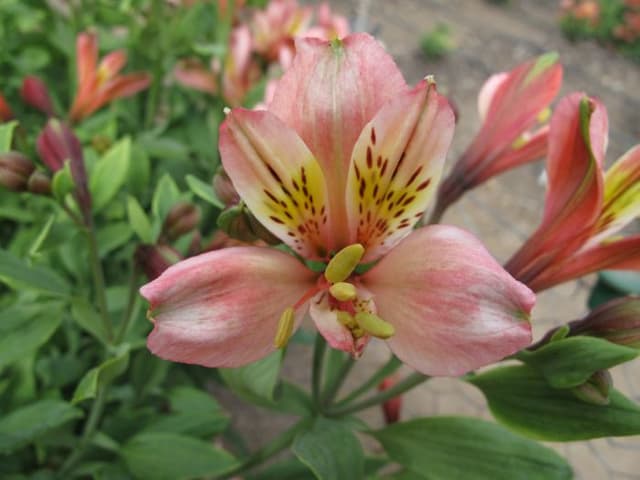
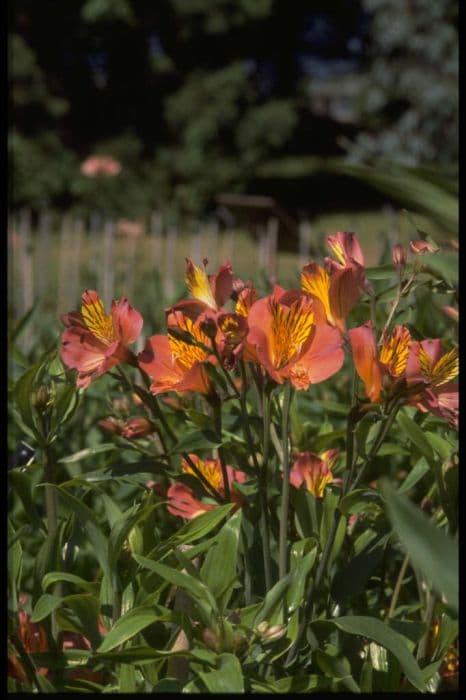
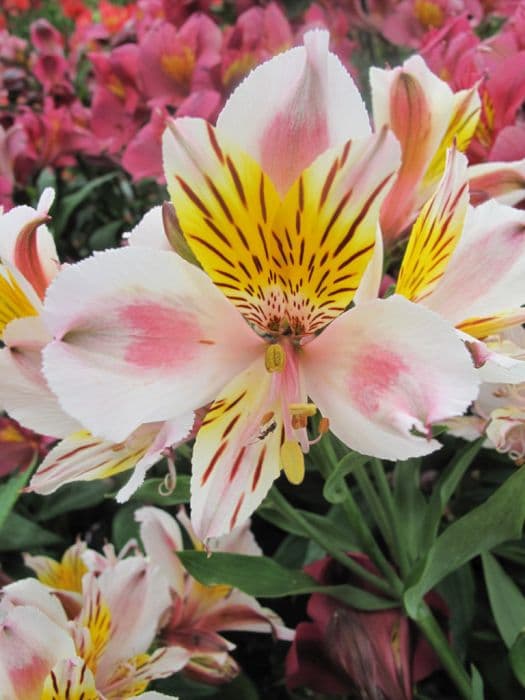
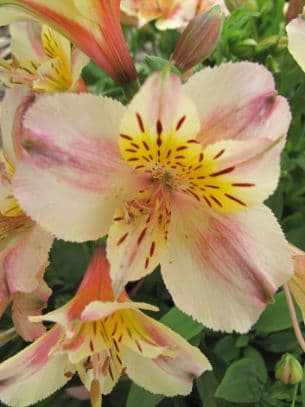
![Peruvian lily [Princess Carmina]](/_next/image?url=https%3A%2F%2Fplants-admin.emdemapps.com%2Fimages%2Fplants%2F%2Fimages%2F604b5b436505f.png&w=640&q=75)

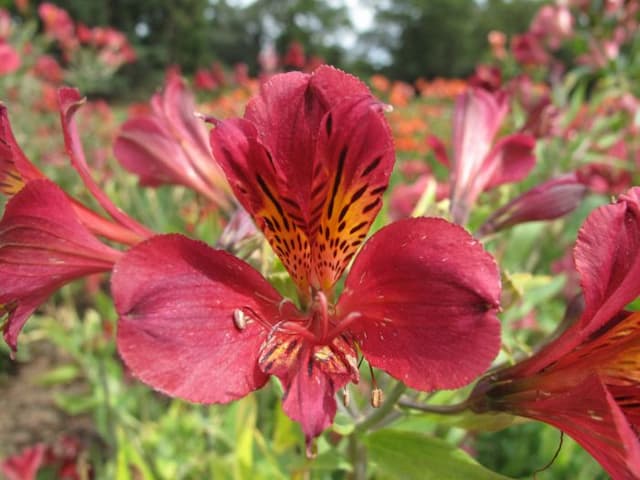
![Peruvian lily [Inca Glow]](/_next/image?url=https%3A%2F%2Fplants-admin.emdemapps.com%2Fimages%2Fplants%2F%2Fimages%2F604b5e99e48d9.png&w=640&q=75)
![Peruvian lily [Inca Smile]](/_next/image?url=https%3A%2F%2Fplants-admin.emdemapps.com%2Fimages%2Fplants%2F%2Fimages%2F604b5cad8fa91.png&w=640&q=75)